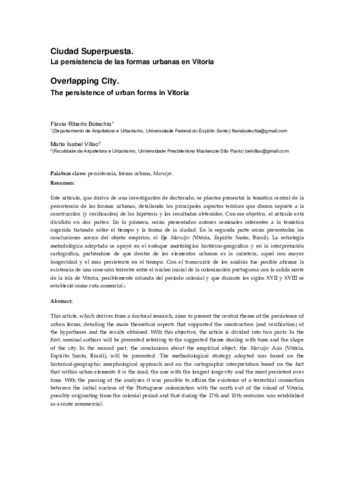Mostra el registre d'ítem simple
Ciudad Superpuesta: la persistencia de las formas urbanas en Vitoria
| dc.contributor.author | Botechia, Flavia Ribeiro |
| dc.contributor.author | Villac, Maria Isabel |
| dc.coverage.spatial | east=-40.31300067901611; north=-20.295810282328013; name=Av. Maruípe, 1750 - Maruípe, Vitória - ES, 29047-185, Brasil |
| dc.date.accessioned | 2020-09-18T06:45:40Z |
| dc.date.available | 2020-09-27T00:26:14Z |
| dc.date.issued | 2020-09-28 |
| dc.identifier.citation | Botechia, F.R.; Villac, M.I. Ciudad Superpuesta: la persistencia de las formas urbanas en Vitoria. A: Llop, C.; Cervera, M.; Peremiquel, F. (eds.). "IV Congreso ISUF-H: Metrópolis en recomposición: prospectivas proyectuales en el Siglo XXI: Forma urbis y territorios metropolitanos, Barcelona, 28-30 Septiembre 2020". Barcelona: DUOT, UPC, 2020, p. 1-13. ISBN 978-84-9880-841-4. |
| dc.identifier.isbn | 978-84-9880-841-4 |
| dc.identifier.uri | http://hdl.handle.net/2117/328900 |
| dc.description.abstract | Este artículo, que deriva de una investigación de doctorado, se plantea presentar la temática central de la persistencia de las formas urbanas, detallando los principales aspectos teóricos que dieron soporte a la construcción (y verificación) de las hipótesis y los resultados obtenidos. Con ese objetivo, el artículo está dividido en dos partes: En la primera, serán presentados autores seminales referentes a la temática sugerida tratando sobre el tiempo y la forma de la ciudad. En la segunda parte serán presentadas las conclusiones acerca del objeto empírico, el Eje Maruípe (Vitória, Espírito Santo, Brasil). La estrategia metodológica adoptada se apoyó en el enfoque morfológico histórico-geográfico y en la interpretación cartográfica, partiéndose de que dentro de los elementos urbanos es la carretera, aquel con mayor longevidad y el más persistente en el tiempo. Con el transcurrir de los análisis fue posible afirmar la existencia de una conexión terrestre entre el núcleo inicial de la colonización portuguesa con la salida norte de la isla de Vitoria, posiblemente oriunda del período colonial y que durante los siglos XVII y XVIII se estableció como ruta comercial. |
| dc.description.abstract | This article, which derives from a doctoral research, aims to present the central theme of the persistence of urban forms, detailing the main theoretical aspects that supported the construction (and verification) of the hypotheses and the results obtained. With this objective, the article is divided into two parts: In the first, seminal authors will be presented referring to the suggested theme dealing with time and the shape of the city. In the second part, the conclusions about the empirical object, the Maruípe Axis (Vitória, Espirito Santo, Brazil), will be presented. The methodological strategy adopted was based on the historical-geographic morphological approach and on the cartographic interpretation based on the fact that within urban elements it is the road, the one with the longest longevity and the most persistent over time. With the passing of the analyzes it was possible to affirm the existence of a terrestrial connection between the initial nucleus of the Portuguese colonization with the north exit of the island of Vitoria, possibly originating from the colonial period and that during the 17th and 18th centuries was established as a route commercial. |
| dc.format.extent | 13 p. |
| dc.language.iso | spa |
| dc.publisher | DUOT, UPC |
| dc.rights | Attribution-NonCommercial-NoDerivs 3.0 Spain |
| dc.rights.uri | http://creativecommons.org/licenses/by-nc-nd/3.0/es/ |
| dc.subject | Àrees temàtiques de la UPC::Urbanisme |
| dc.subject.lcsh | Vitória (Espírito Santo, Brazil) -- History |
| dc.subject.other | Maruípe |
| dc.subject.other | Persistencia |
| dc.subject.other | Forma urbana |
| dc.subject.other | Persistence |
| dc.subject.other | Urban form |
| dc.title | Ciudad Superpuesta: la persistencia de las formas urbanas en Vitoria |
| dc.title.alternative | Overlapping City: the persistence of urban forms in Vitoria |
| dc.type | Conference report |
| dc.subject.lemac | Morfologia urbana -- Brasil -- Vitória (Espírito Santo) |
| dc.subject.lemac | Vitória (Espírito Santo, Brasil) -- Història |
| dc.rights.access | Open Access |
| local.citation.contributor | Llop, C.; Cervera, M.; Peremiquel, F. (eds.) |
| local.citation.pubplace | Barcelona |
| local.citation.publicationName | IV Congreso ISUF-H: Metrópolis en recomposición: prospectivas proyectuales en el Siglo XXI: Forma urbis y territorios metropolitanos, Barcelona, 28-30 Septiembre 2020 |
| local.citation.startingPage | 1 |
| local.citation.endingPage | 13 |


